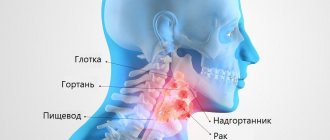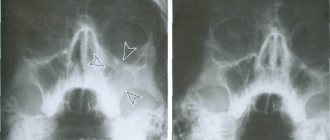Sore throat - this unpleasant symptom is familiar, if not to everyone, then at least to every second person. It signals that an upper respiratory tract disease is developing. As a rule, inflammation of the throat mucosa occurs in parallel with other unpleasant symptoms: acute sore throat or fever.
Many people associate a sore throat with a cold. A sick person first treats his throat with lozenges and sprays purchased at the pharmacy, takes antiviral drugs, tries folk remedies on himself... And in the end he does not understand why this treatment of the disease does not work, and the symptoms of the disease do not go away.
You need to understand that a cold is not the only cause of inflammation. And inflammation of the mucous membrane of the throat is not always associated with ENT diseases.
Before starting treatment of the throat mucosa, it is necessary to conduct a high-quality diagnosis from an ENT doctor to determine the real causes of sore throat. Only after this is it possible to begin treatment.
From our new article you will learn what signs of inflammation of the throat mucosa exist, what are the main causes of inflammation and how to treat inflammation of the throat mucosa.
Forms of pharyngitis
According to its clinical course, pharyngitis can be chronic and acute.
The chronic form is divided into:
- hypertrophic – this is an increase in mucous membrane;
- atrophic – this is the depletion of the mucous membrane;
- catarrhal – standard inflammation.
The acute form also exists in three types:
- allergic – provoked by allergens;
- infectious – caused by pathogenic microorganisms;
- post-traumatic – occurs due to contact with the mucous membrane of irritating substances.
Reasons for the development of the disease
In most cases, acute pharyngitis does not act as an independent pathology, but is only a manifestation of a general infectious process. Many infections (diphtheria, scarlet fever, measles, influenza) debut as an acute form of pharyngitis and are therefore not diagnosed in a timely manner.
In 70% of cases, acute inflammation of the pharynx is caused not by bacteria, but by viruses. Most often this is:
- influenza and parainfluenza viruses;
- rhinoviruses;
- adenoviruses;
- Epstein-Bar viruses;
- cytomegalovirus family;
- enteroviruses.
Only 30% of cases of acute pharyngitis are caused by bacterial flora:
- staphylococci;
- pneumococci;
- streptococci of groups A, C, G;
- Corynebacterium diphtheria;
- hemophilus influenzae;
- atypical pathogens are chlamydia and mycoplasma.
The latter are called atypical, because settle inside cells, and not on the surface of the mucosa, so the immune system cannot detect them. For this reason, such inflammatory processes take a long time, creating significant difficulties in carrying out etiotropic (acting on the cause) therapy.
In a small percentage of cases, pharyngitis is caused by fungal flora. As a rule, this is due to a general weakening of the immune system or local immunodeficiency (for example, in smokers). This is also facilitated by long-term use of antibacterial drugs.
If not treated correctly, acute pharyngitis can become chronic. Most often, pharyngitis caused by cytomegalovirus infection, Epstein-Barr virus, chlamydial and mycoplasma infection is chronic, since these microorganisms live inside cells and are not affected by local antibacterial and antiviral therapy. But inflammation caused by streptococci and staphylococci can also become chronic.
The development of chronic pharyngitis is a consequence of one of two processes:
- chronicity of acute inflammation of the pharynx due to poor immune defense;
- secondary infection of the pharynx from infectious foci located in the body (carious teeth, inflammation of the ENT organs, diseases of the digestive tract, etc.).
Factors that increase the likelihood of pharyngitis:
- hypothermia of the whole body or only the upper respiratory tract;
- alcohol abuse;
- eating sour, spicy, hot or cold foods;
- nasal breathing disorder.
Breathing through the nose becomes difficult in conditions such as:
- deviated nasal septum;
- nasal polyps;
- hypertrophy of the inferior turbinates;
- allergic rhinitis.
In these cases, a person has to breathe through his mouth, and this dries out the oral mucosa and reduces local immunity, because The production of immunoglobulin A decreases.
Atrophic pharyngitis is also provoked by other causative factors:
- lack of vitamins;
- anemia;
- functional heart failure;
- renal failure;
- diabetes;
- decreased thyroid function (hypothyroidism);
- menopausal syndrome.
We care about your health
Pharyngitis is an inflammation that is localized on the mucous membrane and lymphoid tissue of the pharynx. Since this disease is usually of infectious origin, it is usually accompanied by symptoms of upper respiratory tract dysfunction. If signs of illness occur, it is recommended to immediately contact an experienced ENT specialist. Thanks to this, you will be able to prevent the development of complications.
Pharyngitis (acute, chronic) - symptoms in adults and children
Pharyngitis is accompanied by severe inflammation in the pharynx area, which is associated with increased activity of pathogenic microorganisms. The development of the disease can be caused by cytomegalovirus or Epstein-Barr virus, which are viable at low temperatures.
Infection of the pharynx by these microorganisms usually occurs as complications of diseases of the ENT organs. Acute inflammation often spreads to the tonsils, creating a large lesion.
If treatment for this disease is not started in a timely manner, it will become chronic. In such cases, coping with pharyngitis can be quite difficult.
Pharyngitis - photo of the throat with disease
Photograph of the throat with acute pharyngitis
Photograph of acute infectious pharyngitis
Causes of pharyngitis
The development of pharyngitis can be caused by inhalation of cold air, as well as exposure to various irritants - alcoholic beverages, cigarettes. The infectious form of the disease is a consequence of infection with various microbes - staphylococci, pneumococci, streptococci. Pharyngitis can also develop when infected with various viruses and fungal infections.
Often the disease becomes a consequence of infection from other organs adjacent to the pharynx. Very often the inflammatory process is the result of rhinitis, sinusitis or caries.
Provoking factors include the following:
- prolonged hypothermia;
- weakening of the immune system;
- prolonged irritation of the mucous membrane;
- infectious processes in the body;
- eating cold foods.
People of any age are at risk, but pharyngitis is most often diagnosed in children and patients with weak immune systems. If therapy is not started in a timely manner, a chronic form of the disease may develop.
Symptoms of pharyngitis in adults and children
The general condition of people suffering from pharyngitis usually remains normal. Sometimes the temperature rises, increased drowsiness or slight malaise appears. Local symptoms include discomfort in the throat, dryness, soreness, and the sensation of a foreign object in the throat. Subsequently, pain of moderate intensity occurs.
If there is pronounced swelling in the throat area, the pain syndrome spreads to the ears, which provokes a feeling of stuffiness. Also, against the background of a sore throat, a dry cough may appear. As the pathology develops, it acquires a productive character.
Since pharyngitis is an inflammatory process, a reaction from the lymphatic system may occur. As a result, there is a slight increase in the anterior cervical lymph nodes and slight pain when palpating them.
With a severe viral infection, a person may have more pronounced signs of intoxication of the body. In addition to pharyngitis, symptoms of dysfunction of other organs often appear - for example, laryngitis or tracheitis.
With an exacerbation of the chronic form of pharyngitis, the patient’s well-being remains normal. In this state there are no symptoms of intoxication, in addition, the temperature usually remains normal. The chronic disease is accompanied by increased dryness and a feeling of a lump in the throat. Sometimes there is a slight cough.
What does Pharyngitis look like?
Pharyngitis - what does the throat look like when it’s sick?
Photo of pharyngitis
Treatment methods for pharyngitis - acute and chronic
For therapy to be truly effective, an accurate diagnosis must be made in time. To do this, you should consult with an ENT doctor who will examine the oral cavity. To determine the type of pathogen, a specialist will take a swab from the throat.
If the patient's general condition remains normal, treatment of pharyngitis should be symptomatic.
It usually includes the following components:
- gentle diet;
- compresses on the neck;
- gargling;
- inhalation;
- hot drink;
- warm foot baths.
Mild forms of the disease do not require the use of antibiotics. In this case, local antimicrobial therapy is indicated. The doctor may also prescribe antiseptic, anti-inflammatory and painkillers.
To determine the treatment method and select the right drug, the ENT specialist must focus on the following criteria:
- wide spectrum of action of the drug;
- low degree of absorption of the active substance from the mucous membrane;
- low allergenicity;
- no irritation to the throat;
- no toxic effect.
ENT clinic Medkvadrat is an effective treatment for pharyngitis in Moscow, Kurkino and Khimki. We will quickly and effectively cure pharyngitis. Make an appointment with an ENT specialist.
Prevention of pharyngitis
To prevent the development of acute pharyngitis, it is necessary to exclude hypothermia. It is also very important to avoid irritation of the pharyngeal mucosa with agents of nutritional origin. To prevent this disease, general hardening of the body with cold should be carried out, timely sanitation of the oral cavity should be ensured, and inflammation of the nasopharynx should be treated in time.
To prevent the occurrence of chronic pharyngitis, it is necessary to exclude exposure to negative factors on the body. These include smoking, eating irritating foods, and air pollution. Adequate treatment of pathologies of internal organs and metabolic disorders in the body is of no small importance.
Pharyngitis is a fairly common disease that is accompanied by inflammation in the pharynx and causes unpleasant symptoms. To prevent negative health consequences, you need to prevent this disease. If symptoms do appear, you should immediately consult a specialist.
You can make an appointment at a convenient time by phone. + 7
Overview video of the Medkvadrat ENT center in Moscow, Kurkino and Khimki:
Clinical picture
The acute form manifests itself:
- sore throat, which sometimes radiates to the ears if the lateral pharyngeal ridges become inflamed;
- a feeling of tickling and burning;
- dryness and discomfort in the throat;
- slight rise in temperature (usually no more than 38.0°C).
When palpating the lymph nodes of the neck, they are determined to be enlarged and painful. Examination of the pharynx reveals redness of its posterior wall and palatine arches, granularity is clearly visible (enlarged lymphoid foci of a brighter color than the surrounding mucosa). An important differential sign is the absence of inflammation in the tonsils with pharyngitis. This distinguishes it from a sore throat.
Chronic inflammatory lesions of the pharynx are easier than acute ones - fever and general deterioration in health are almost always absent. Usually the patient is concerned about:
- feeling of dryness and sore throat;
- dry cough with attacks;
- sensation of a lump or foreign body in the throat.
Due to the fact that mucous secretion accumulates on the back wall, a person constantly needs to swallow it. This causes significant discomfort.
The atrophic type of pharyngitis is accompanied by thinning and dryness of the mucous membrane, through which the vessels are visible. On its surface there may be crusts of dried mucous secretion.
The hypertrophic form is diagnosed by the presence of overgrown foci of lymphoid tissue, which are determined in the form of granules or strands. They are located behind the lateral pharyngeal ridges (these are the posterior arches of the palate). During an exacerbation, hyperplastic areas swell, increase in size, acquire a bright pink color, and foci of abscess formation may appear in them.
Infectious causes of inflammation: symptoms and treatment
An inflammatory process in the pharyngeal mucosa may indicate the development of diseases such as:
- ARVI;
- tonsillitis;
- pharyngitis;
- pharyngomycosis;
- laryngitis;
- candidiasis.
Acute respiratory viral infection is the most common cause of unpleasant symptoms. The disease occurs with characteristic symptoms: dry and sore throat, nasal congestion, runny nose, elevated body temperature. Treatment with antibiotics in this situation is ineffective, since the causative agent of the disease is viruses, not bacteria. This is another common mistake made by self-medicators. For acute respiratory viral infections, it is necessary to take antiviral drugs. A sore throat can be gargled with herbal decoctions, such as chamomile, or irrigated with sprays. You can suck on special lozenges that temporarily relieve pain in the throat.
Tonsillitis is a well-known sore throat, in which the palatine tonsils, or in other words, tonsils, become inflamed. The tonsils are located on the sides of the pharynx and are organs of the human immune system. The disease occurs with a very high temperature (under 40 degrees). The main signs of a sore throat: reddened walls of the throat, severe pain in it, difficulty swallowing, inflamed lymph nodes. A characteristic symptom of tonsillitis is a white coating on the tonsils. The causative agent of sore throat is bacteria, so the disease is treated with antibiotics. The drug and the optimal dosage for treatment are prescribed only by an ENT doctor. Self-medication is strictly prohibited! If a sore throat is treated incorrectly, dangerous complications from the kidneys, heart and joints can occur. The patient requires strict bed rest and plenty of fluids. It is also useful to irrigate the throat with antiseptics and rinse.
Pharyngitis - the main symptoms of pharyngitis: dry cough, sore throat, constant dry mouth, pain during swallowing. Another characteristic sign of the disease is the feeling of a lump in the throat. What to do if you have a sore throat in this case? Avoid too hot, cold or spicy foods, drink plenty of fluids, and rinse. Effective treatment of the throat is prescribed only by an ENT doctor. Otherwise, the inflammatory process can become chronic.
Pharyngomycosis is a type of pharyngitis. The only difference is the type of pathogen. In pharyngomycosis, inflammation is caused by fungi. Treatment consists of taking antifungal drugs.
Laryngitis is an inflammation of the larynx and vocal cords. The main signs of the disease are a strong “barking” cough, a hoarse voice, and a scratching sensation in the larynx. In some cases, the voice may disappear completely. Therapeutic therapy includes inhalations, rinses and complete vocal rest.
With candidiasis, the mucous membrane of the oropharynx is affected by a fungal infection. Very often, the disease manifests itself against the background of other diseases in the body, for example, diabetes.
Diagnosis of pharyngitis
In the diagnosis of acute pharyngitis, pharyngoscopy, determination of the pathogen (PCR, bacteriological and mycological examination of smears from the pharyngeal mucosa) and laboratory examination (clinical blood test, inflammatory markers, general urine analysis) are of key importance. The data obtained during diagnosis allows you to select the correct treatment, avoid complications and chronicity of the process.
In the diagnosis of chronic pharyngitis, the search for primary foci of infection is important. For this purpose the following is carried out:
- X-ray examination of the nasal cavity, paranasal sinuses and oral cavity (computed tomography of the paranasal sinuses, dental CT);
- endoscopic examination of the nasopharynx;
- esophagogastroduodenoscopy.
A detailed laboratory examination is carried out. In addition to a clinical blood test, it is necessary to conduct an examination for chronic viral infections and intracellular bacterial infections, and exclude the allergenic factor.
In some cases, a detailed examination of the immune system is required, since a decrease in local immunity leads to chronic infection.










